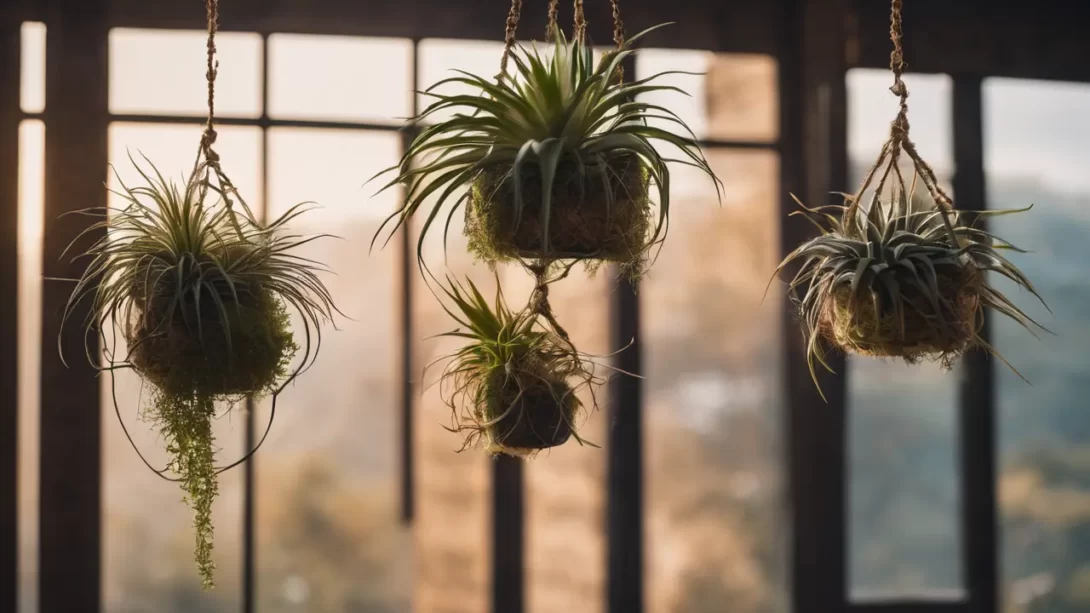Air plants, scientifically known as Tillandsia, have captured the attention of plant enthusiasts due to their unique ability to grow without soil. These fascinating plants absorb water and nutrients through their leaves, making them versatile for various creative display options, including hanging arrangements. Proper display and care are crucial for the health and growth of air plants, turning them into stunning, gravity-defying elements in home décor.
Air Plants
Air plants are part of the bromeliad family and are native to the forests, mountains, and deserts of Central and South America. They thrive in environments with good air circulation and bright, indirect light. Unlike traditional potted plants, air plants absorb moisture and nutrients through their leaves, not roots. This characteristic allows them to be displayed in unique ways, especially in hanging designs. It’s important to understand their light and water needs to ensure they stay healthy and vibrant.
Choosing the Right Location
Selecting the right location is vital for the well-being of hanging air plants. They require bright, indirect light, so areas near windows that receive filtered sunlight are ideal. For outdoor displays, shaded patios or balconies that avoid direct midday sun are suitable. Air circulation is equally important; avoid enclosed or stuffy areas, as air plants thrive in breezy environments. Consider the humidity of the chosen location as well; bathrooms can be great for providing the moisture that air plants love.
Types of Displays for Hanging Air Plants
There are various creative ways to display hanging air plants, each bringing its unique aesthetic:
- Wire Holders: These can be bent and shaped to hold air plants, offering a minimalist look.
- Macramé Hangers: These use woven cords and can house air plants in a bohemian style.
- Glass Terrariums: Clear glass containers can create a modern, terrarium-like display.
- Mesh or Geometric Frames: These provide a contemporary feel and can be hung on walls or ceilings.
Each type of display has its advantages. Wire holders and mesh frames allow for excellent air circulation, which is crucial for air plant health. Macramé hangers and glass terrariums, while potentially restricting airflow, can create stunning visual impacts when placed in well-ventilated areas. The choice of display can significantly affect the aesthetic and health of the air plants.
Materials Needed for Hanging Air Plants
To create a hanging display for air plants, you’ll need a few essential materials. The specifics will depend on the type of display you choose, but here are some common items:
- Hooks or Nails: For securing displays to walls or ceilings.
- Fishing Line or Clear String: Ideal for creating an invisible support for air plants in open designs.
- Adhesive: A plant-safe glue for attaching air plants to certain holders or frames.
- Decorative Elements: Items like driftwood, shells, or stones can add a natural and artistic touch to your display.
These materials can usually be found in craft stores or online. Ensure that any adhesive used is safe for plants and won’t damage their delicate tissues.
Preparing the Air Plants
Before attaching air plants to your chosen display, it’s essential to prepare them properly. If they’ve been shipped to you, give them a good soak in water for about 30 minutes to rehydrate. Gently shake off excess water and let them dry completely before attaching them to the display. This prevents water from getting trapped in their bases, which can lead to rot.
When attaching air plants to a display, be gentle. Their leaves are hardy, but their roots (if present) are delicate. If using adhesive, apply a small amount to the plant’s base, not the leaves. For wire or mesh displays, gently thread the air plant in without bending or breaking the leaves.
Step-by-Step Guide to Hanging Air Plants
- Creating a Wire Holder Display:
- Bend the wire into a shape that supports the air plant’s base.
- Attach the wire holder to a hook or nail on your wall or ceiling.
- Gently place the air plant inside the holder, ensuring it’s secure.
- Making a Macramé Hanger:
- Weave the macramé string into your desired design, leaving a space to nestle the air plant.
- Hang the macramé from a ceiling hook or wall nail.
- Place the air plant within the space, adjusting the string to hold it in place.
- Setting Up a Glass Terrarium:
- Fill the bottom of the terrarium with decorative elements like stones or sand.
- Position the air plant inside the terrarium, ensuring it doesn’t touch the sides.
- Hang or place the terrarium in a bright, airy spot.
- Assembling a Mesh or Geometric Frame:
- Secure the frame on a wall or from a ceiling hook.
- Carefully attach the air plants to the frame using wire or adhesive.
- Arrange them in a visually pleasing pattern.
In each case, ensure that the air plant is secure but not constricted, and that the display allows for adequate air flow around the plant. Safety is key, especially when hanging displays from ceilings or high walls. Use sturdy hooks and check the strength of your setup to prevent any falls.
Maintenance and Care
Proper maintenance is crucial for the health of hanging air plants. Here are some essential care tips:
- Watering: Air plants need regular watering to thrive. Soak them in water for about 30 minutes once a week. Shake off any excess water and let them dry completely before placing them back in their display. In drier climates or during hot seasons, misting between soakings can provide additional moisture.
- Light: Ensure your air plants receive bright, indirect light. If they’re too far from a natural light source, consider using artificial grow lights. Avoid direct sunlight, as it can scorch their leaves.
- Feeding: You can fertilize your air plants once a month with a bromeliad or orchid fertilizer diluted to quarter strength. This provides them with essential nutrients that they would normally gather from the air.
- Pruning: Occasionally, air plants may develop brown or dead leaves at their base or tips. Gently prune these off to keep the plant healthy and aesthetically pleasing.
Troubleshooting Common Issues
Even with proper care, air plants can sometimes encounter problems. Here are some common issues and their solutions:
- Brown or Wilting Leaves: This may indicate under-watering. Increase your watering frequency, making sure to fully soak the plant.
- Black or Rotten Base: Overwatering or insufficient drying after watering can lead to rot. Reduce watering frequency and ensure the plant dries fully before returning it to its display.
- Lack of Growth: Insufficient light can stunt growth. Move your air plant to a brighter location, avoiding direct sunlight.
Conclusion
Hanging air plants provide an excellent opportunity to get creative with plant display and add a touch of greenery to any space. With their minimal soil requirements and unique aesthetic, they are perfect for modern, space-saving décor. By following these guidelines for selection, display, and care, you can ensure that your air plants remain healthy and vibrant, bringing life and beauty to your home or office. Remember, the key to thriving air plants is balancing their light, water, and air needs while showcasing them in a way that complements your personal style.



